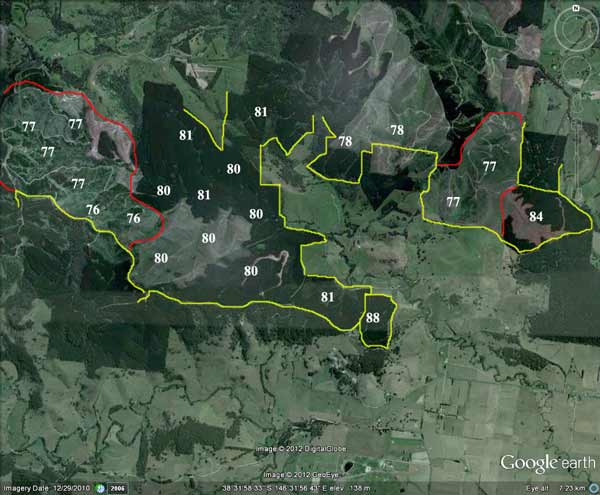

Jack River Catchment showing extent of plantations within LEGL93-94 (numbers eg 76 refer to the year of plantation establishment). Approximately 50ha appear to have been planted in 1976 (plantations within red line).
Plantations established in 1977/81 (`~1130ha) were most likely established with a concoction of Amitrole (Weedagol T.L. Plus) and (Gesaprim 500) Atrazine may have been sprayed. In 2002 scientists in the United States found that Atrazine at levels as low of 0.1part per billion altered hormones in frogs. Since then Atrazine has been found to have the same effect across a range of animals. 1130ha would probably have been sprayed with the Atrazine (4 l/ha/Amitrole 7l/ha) mixture. Totals 4520 litres Atrazine, 7910 litres Amitrole). The highest risk years for drinking water quality would have been between 1976-82.
Prior to September 1976, it is highly likely that aerial application of 2,4,5-T @ 1.1 litres a hectare occurred. ~50ha would have been aerially sprayed with 2,4,5-T in 1976. 55Litres of 245-T would most likely have been used in the catchment with 2500 litres of diesel.
Perhaps 40 houses (120 people) may have been accessing drinking water from the Jack River during plantation establishment time.

November 2001: Remnant vegetation and pine plantations in Jack River catchment.
Herbicides Used by Grand Ridge Plantations - Strzelecki Ranges and Gippsland Victoria
| Herbicide | Label Rate max as kg/ha | Used to control | Euc/Rad | Notes | Application |
| Clopyralid | 2.55 | Woody Weeds | Radiata and Eucalypts | Highly Toxic/Potential Ground water Contaminant | aerial or ground |
| Glufosinate Ammonium | 1 | Woody Weeds | Radiata | aerial or ground | |
| Glyphosate | 3.6 | Herbaceous and woody weeds, noxious weeds | Radiata, Eucalpts and Custodial | ||
| Haloxyfop-methyl | 0.13 | Annual and Pernneial Grasses | Eucalypts | Carcinogen | aerial or ground |
| Hexazinone | 4 | Woody Weeds | Radiata | Ground Water Contaminant | Aerial, ground, spot |
| Metsulfuron-Methyl | 0.06 | Woody Weeds, Noxious Weeds | Radiata, Eucalyptus and Custodial | Potential Ground Water Contaminant | Aerial, ground or spot |
| Sulfometuron Methyl | 0.6 | Annual and Perennial Grasses and broadleaf weeds | Eucalyptus | Potential Ground Water Contaminant | Aerial or Ground |
November 2001: Gully of tributary of Jack River.
Hancock Watch visit November 2001: This is a large plantation mass stretching approximately 6km east to west and about 2-3 km north to south. Access was made into the plantation via Kalladay Road through pine plantations established in the late seventies. At the junction of Jack River Road we headed west then north. A small portion of the plantation on the easterly side was native vegetation including a tributary of the Jack River. Most of this area was dominated by farmland and radiata pine. After returning back to Kalladay Road we then headed west along Egans Road alongside plantations established in the early eighties. No logging appeared to be occurring although some of the slopes appeared to be quite steep. More work is needed to be done understanding this area.